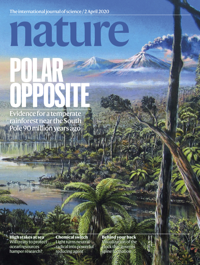Researchers have found unexpected fossil traces of a temperate rainforest near the South Pole 90 million years ago, suggesting the continent had an exceptionally warm climate in prehistoric times.
A team from the UK and Germany, which includes experts from Northumbria University’s Department of Geography and Environmental Sciences, discovered a forest soil from the Cretaceous period in the seabed near the South Pole.
Their analysis of the pristinely preserved roots, pollen and spores show that the world at that time was a lot warmer than previously thought, with rainforests in Antarctica similar to the forests we have in New Zealand today. The international team’s findings are published today as the lead story in the scientific journal Nature.

Co-author Professor Ulrich Salzmann, a palaeoecologist at Northumbria University, used the preserved pollen and spores to reconstruct the past vegetation and climate. He describes the process of reconstructing past environments and climates as similar to working on a huge jigsaw puzzle, which revealed an amazingly detailed picture of the past Antarctic landscape.
“It was particularly fascinating to see the well-preserved diverse fossil pollen and other plant remains in a sediment deposited some 90 million years ago, near the South Pole,” he said.“The numerous plant remains indicate that the coast of West Antarctica was, back then, a dense temperate, swampy forest, similar to the forests found in New Zealand today.”
When they pieced together their analyses, the international research team found evidence for a mild climate around 500 miles from the South Pole, with annual mean air temperatures of about 12 degrees Celsius. This is roughly the mean temperature of Hobart, Australia, today.
Summer temperatures averaged 19 degrees Celsius and water temperatures in rivers and swamps reached up to 20 degrees. This was despite a four-month polar night, meaning for a third of every year there was no life-giving sunlight at all. They also found that the amount and intensity of rainfall in West Antarctica was similar to that in Wales today.
Such climate conditions could only be achieved with a dense vegetation cover on the Antarctic continent and the absence of any major ice-sheets in the South Pole region, as pictured in the artists’ impression of the landscape above. Carbon dioxide concentration in the atmosphere was also far higher than previously assumed. Read more.